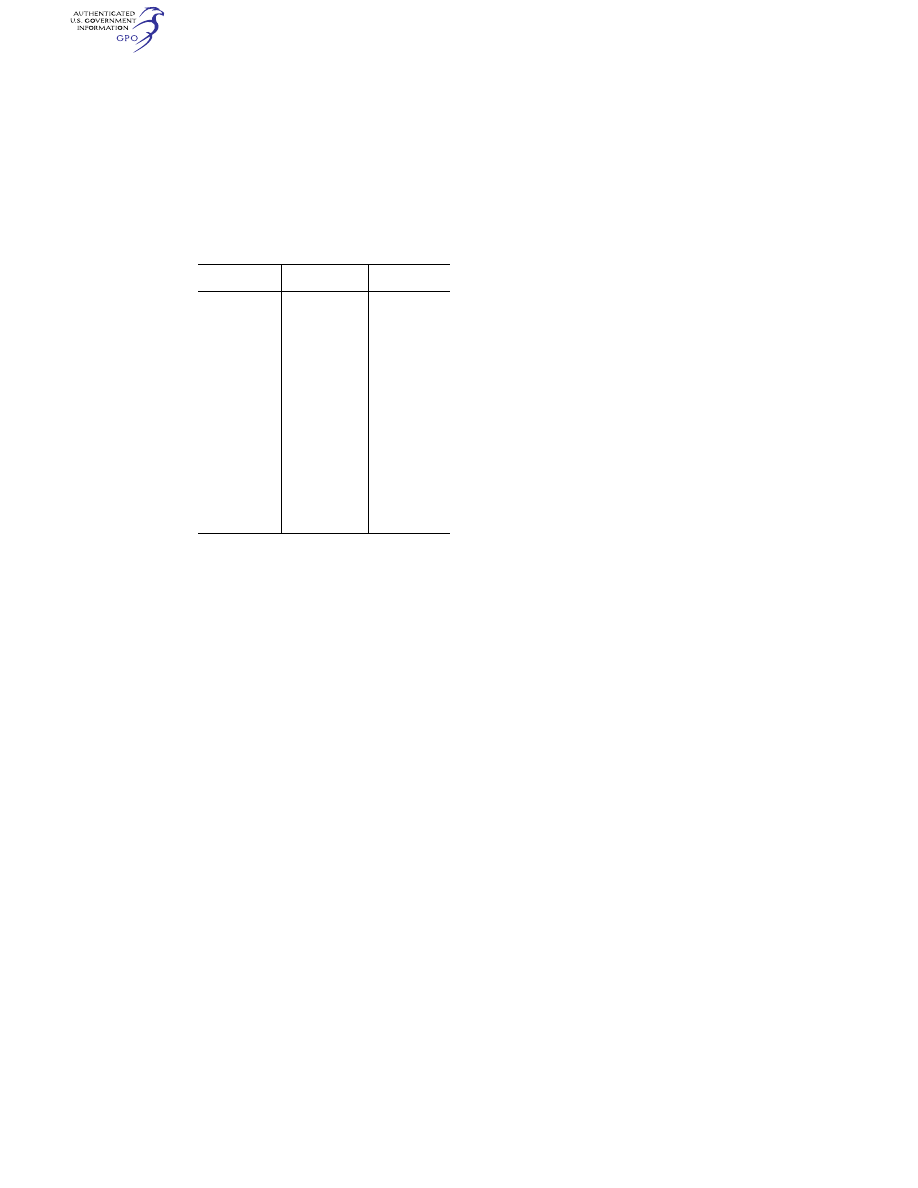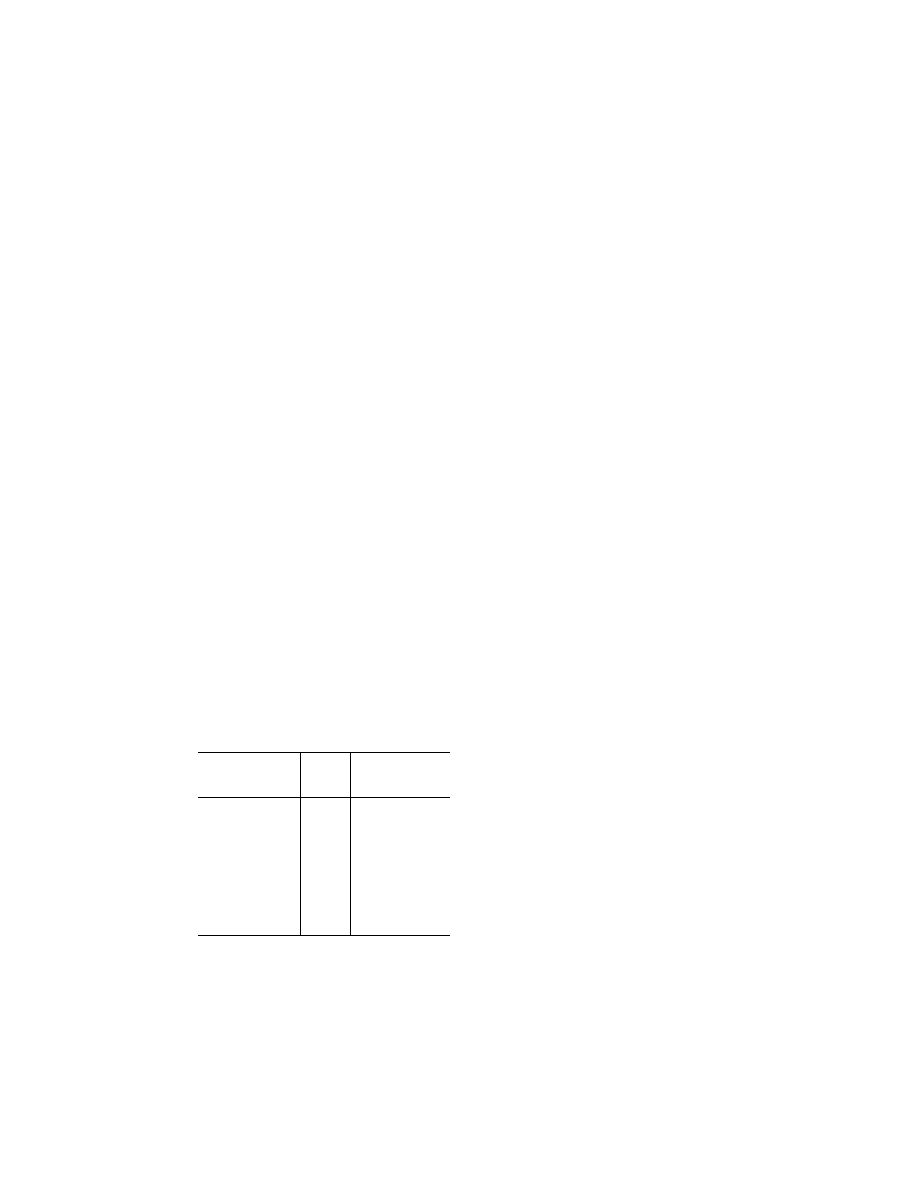
894
14 CFR Ch. I (1–1–24 Edition)
Pt. 105
Airspace Flight
visibility
Distance from
clouds
At or above
10,000 feet
MSL.
5 statute miles ......
1,000 feet below.
1,000 feet above.
1 statute mile hori-
zontal.
Class G:
1,200 feet or
less above the
surface (re-
gardless of
MSL altitude).
1 statute mile .......
Clear of clouds.
More than 1,200
feet above the
surface but
less than
10,000 feet
MSL.
1 statute mile .......
500 feet below.
1,000 feet above.
2,000 feet hori-
zontal.
More than 1,200
feet above the
surface and at
or above
10,000 feet
MSL.
5 statute miles ......
1,000 feet below.
1,000 feet above.
1 statute mile hori-
zontal.
[Amdt. 103–17, 56 FR 65662, Dec. 17, 1991]
PART 105—PARACHUTE
OPERATIONS
Subpart A—General
Sec.
105.1
Applicability.
105.3
Definitions.
105.5
General.
105.7
use of alcohol and drugs.
105.9
Inspections.
Subpart B—Operating Rules
105.13
Radio equipment and use require-
ments.
105.15
Information required and notice of
cancellation or postponement of a para-
chute operation.
105.17
Flight visibility and clearance from
cloud requirements.
105.19
Parachute operations between sunset
and sunrise.
105.21
Parachute operations over or into a
congested area or an open-air assembly
of persons.
105.23
Parachute operations over or onto
airports.
105.25
Parachute operations in designated
airspace.
Subpart C—Parachute Equipment and
Packing
105.41
Applicability.
105.43
Use of single-harness, dual-parachute
systems.
105.45
Use of tandem parachute systems.
105.47
Use of static lines.
105.49
Foreign parachutists and equipment.
A
UTHORITY
: 49 U.S.C. 106(g), 40113–40114,
44701–44702, 44721.
S
OURCE
: Docket No. FAA–1999–5483, 66 FR
23553, May 9, 2001, unless otherwise noted.
§ 105.1
Applicability.
(a) Except as provided in paragraphs
(b) and (c) of this section, this part pre-
scribes rules governing parachute oper-
ations conducted in the United States.
(b) This part does not apply to a
parachute operation conducted—
(1) In response to an in-flight emer-
gency, or
(2) To meet an emergency on the sur-
face when it is conducted at the direc-
tion or with the approval of an agency
of the United States, or of a State,
Puerto Rico, the District of Columbia,
or a possession of the United States, or
an agency or political subdivision
thereof.
(c) Sections 105.5, 105.9, 105.13, 105.15,
105.17, 105.19 through 105.23, 105.25(a)(1)
and 105.27 of this part do not apply to
a parachute operation conducted by a
member of an Armed Force—
(1) Over or within a restricted area
when that area is under the control of
an Armed Force.
(2) During military operations in un-
controlled airspace.
§ 105.3
Definitions.
For the purposes of this part—
Approved parachute means a para-
chute manufactured under a type cer-
tificate or a Technical Standard Order
(C–23 series), or a personnel-carrying
U.S. military parachute (other than a
high altitude, high speed, or ejection
type) identified by a Navy Air Facility,
an Army Air Field, and Air Force-Navy
drawing number, an Army Air Field
order number, or any other military
designation or specification number.
Automatic Activation Device means a
self-contained mechanical or electro-
mechanical device that is attached to
the interior of the reserve parachute
container, which automatically initi-
ates parachute deployment of the re-
serve parachute at a pre-set altitude,
time, percentage of terminal velocity,
or combination thereof.
Direct Supervision means that a cer-
tificated rigger personally observes a
non-certificated person packing a main
parachute to the extent necessary to
VerDate Sep<11>2014
14:00 Mar 14, 2024
Jkt 262047
PO 00000
Frm 00904
Fmt 8010
Sfmt 8010
Q:\14\14V2.TXT
PC31
aworley on LAPBH6H6L3 with DISTILLER

895
Federal Aviation Administration, DOT
§ 105.3
ensure that it is being done properly,
and takes responsibility for that pack-
ing.
Drop Zone means any pre-determined
area upon which parachutists or ob-
jects land after making an intentional
parachute jump or drop. The center-
point target of a drop zone is expressed
in nautical miles from the nearest VOR
facility when 30 nautical miles or less;
or from the nearest airport, town, or
city depicted on the appropriate Coast
and Geodetic Survey World Aero-
nautical Chart or Sectional Aero-
nautical Chart, when the nearest VOR
facility is more than 30 nautical miles
from the drop zone.
Foreign parachutist means a para-
chutist who is neither a U.S. citizen or
a resident alien and is participating in
parachute operations within the United
States using parachute equipment not
manufctured in the United States.
Freefall means the portion of a para-
chute jump or drop between aircraft
exit and parachute deployment in
which the parachute is activated
manually by the parachutist at the
parachutist’s discretion or automati-
cally, or, in the case of an object, is ac-
tivated automatically.
Main parachute means a parachute
worn as the primary parachute used or
intended to be used in conjunction with
a reserve parachute.
Object means any item other than a
person that descends to the surface
from an aircraft in flight when a para-
chute is used or is intended to be used
during all or part of the descent.
Parachute drop means the descent of
an object to the surface from an air-
craft in flight when a parachute is used
or intended to be used during all or
part of that descent.
Parachute jump means a parachute
operation that involves the descent of
one or more persons to the surface
from an aircraft in flight when an air-
craft is used or intended to be used dur-
ing all or part of that descent.
Parachute operation means the per-
formance of all activity for the purpose
of, or in support of, a parachute jump
or a parachute drop. This parachute op-
eration can involve, but is not limited
to, the following persons: parachutist,
parachutist in command and passenger
in tandem parachute operations, drop
zone or owner or operator, jump mas-
ter, certificated parachute rigger, or
pilot.
Parachutist means a person who in-
tends to exit an aircraft while in flight
using a single-harness, dual parachute
system to descend to the surface.
Parachutist in command means the
person responsible for the operation
and safety of a tandem parachute oper-
ation.
Passenger parachutist means a person
who boards an aircraft, acting as other
than the parachutist in command of a
tandem parachute operation, with the
intent of exiting the aircraft while in-
flight using the forward harness of a
dual harness tandem parachute system
to descend to the surface.
Pilot chute means a small parachute
used to initiate and/or accelerate de-
ployment of a main or reserve para-
chute.
Ram-air parachute means a parachute
with a canopy consisting of an upper
and lower surface that is inflated by
ram air entering through specially de-
signed openings in the front of the can-
opy to form a gliding airfoil.
Reserve parachute means an approved
parachute worn for emergency use to
be activated only upon failure of the
main parachute or in any other emer-
gency where use of the main parachute
is impractical or use of the main para-
chute would increase risk.
Single-harness, dual parachute system:
means the combination of a main para-
chute, approved reserve parachute, and
approved single person harness and
dual-parachute container. This para-
chute system may have an operational
automatic activation device installed.
Tandem parachute operation: means a
parachute operation in which more
than one person simultaneously uses
the same tandem parachute system
while descending to the surface from
an aircraft in flight.
Tandem parachute system: means the
combination of a main parachute, ap-
proved reserve parachute, and approved
harness and dual parachute container,
and a separate approved forward har-
ness for a passenger parachutist. This
parachute system must have an oper-
ational automatic activation device in-
stalled.
VerDate Sep<11>2014
14:00 Mar 14, 2024
Jkt 262047
PO 00000
Frm 00905
Fmt 8010
Sfmt 8010
Q:\14\14V2.TXT
PC31
aworley on LAPBH6H6L3 with DISTILLER

896
14 CFR Ch. I (1–1–24 Edition)
§ 105.5
§ 105.5
General.
No person may conduct a parachute
operation, and no pilot in command of
an aircraft may allow a parachute op-
eration to be conducted from an air-
craft, if that operation creates a hazard
to air traffic or to persons or property
on the surface.
§ 105.7
Use of alcohol and drugs.
No person may conduct a parachute
operation, and no pilot in command of
an aircraft may allow a person to con-
duct a parachute operation from that
aircraft, if that person is or appears to
be under the influence of—
(a) Alcohol, or
(b) Any drug that affects that per-
son’s faculties in any way contrary to
safety.
§ 105.9
Inspections.
The Administrator may inspect any
parachute operation to which this part
applies (including inspections at the
site where the parachute operation is
being conducted) to determine compli-
ance with the regulations of this part.
Subpart B—Operating Rules
§ 105.13
Radio equipment and use re-
quirements.
(a) Except when otherwise authorized
by air traffic control—
(1) No person may conduct a para-
chute operation, and no pilot in com-
mand of an aircraft may allow a para-
chute operation to be conducted from
that aircraft, in or into controlled air-
space unless, during that flight—
(i) The aircraft is equipped with a
functioning two-way radio communica-
tion system appropriate to the air traf-
fic control facilities being used; and
(ii) Radio communications have been
established between the aircraft and
the air traffic control facility having
jurisdiction over the affected airspace
of the first intended exit altitude at
least 5 minutes before the parachute
operation begins. The pilot in com-
mand must establish radio communica-
tions to receive information regarding
air traffic activity in the vicinity of
the parachute operation.
(2) The pilot in command of an air-
craft used for any parachute operation
in or into controlled airspace must,
during each flight—
(i) Continuously monitor the appro-
priate frequency of the aircraft’s radio
communications system from the time
radio communications are first estab-
lished between the aircraft and air
traffic control, until the pilot advises
air traffic control that the parachute
operation has ended for that flight.
(ii) Advise air traffic control when
the last parachutist or object leaves
the aircraft.
(b) Parachute operations must be
aborted if, prior to receipt of a required
air traffic control authorization, or
during any parachute operation in or
into controlled airspace, the required
radio communications system is or be-
comes inoperative.
§ 105.15
Information required and no-
tice of cancellation or postpone-
ment of a parachute operation.
(a) Each person requesting an author-
ization under §§ 105.21(b) and 105.25(a)(2)
of this part and each person submitting
a notification under § 105.25(a)(3) of this
part must provide the following infor-
mation (on an individual or group
basis):
(1) The date and time the parachute
operation will begin.
(2) The radius of the drop zone
around the target expressed in nautical
miles.
(3) The location of the center of the
drop zone in relation to—
(i) The nearest VOR facility in terms
of the VOR radial on which it is lo-
cated and its distance in nautical miles
from the VOR facility when that facil-
ity is 30 nautical miles or less from the
drop zone target; or
(ii) the nearest airport, town, or city
depicted on the appropriate Coast and
Geodetic Survey World Aeronautical
Chart or Sectional Aeronautical Chart,
when the nearest VOR facility is more
than 30 nautical miles from the drop
zone target.
(4) Each altitude above mean sea
level at which the aircraft will be oper-
ated when parachutists or objects exist
the aircraft.
(5) The duration of the intended para-
chute operation.
(6) The name, address, and telephone
number of the person who requests the
VerDate Sep<11>2014
14:00 Mar 14, 2024
Jkt 262047
PO 00000
Frm 00906
Fmt 8010
Sfmt 8010
Q:\14\14V2.TXT
PC31
aworley on LAPBH6H6L3 with DISTILLER

897
Federal Aviation Administration, DOT
§ 105.23
authorization or gives notice of the
parachute operation.
(7) The registration number of the
aircraft to be used.
(8) The name of the air traffic control
facility with jurisdiction of the air-
space at the first intended exit altitude
to be used for the parachute operation.
(b) Each holder of a certificate of au-
thorization issued under §§ 105.21(b) and
105.25(b) of this part must present that
certificate for inspection upon the re-
quest of the Administrator or any Fed-
eral, State, or local official.
(c) Each person requesting an author-
ization under §§ 105.21(b) and 105.25(a)(2)
of this part and each person submitting
a notice under § 105.25(a)(3) of this part
must promptly notify the air traffic
control facility having jurisdiction
over the affected airspace if the pro-
posed or scheduled parachute operation
is canceled or postponed.
§ 105.17
Flight visibility and clearance
from cloud requirements.
No person may conduct a parachute
operation, and no pilot in command of
an aircraft may allow a parachute op-
eration to be conducted from that air-
craft—
(a) Into or through a cloud, or
(b) When the flight visibility or the
distance from any cloud is less than
that prescribed in the following table:
Altitude
Flight vis-
ibility
(statute
miles)
Distance from clouds
1,200 feet or less
above the surface re-
gardless of the MSL
altitude.
3 500 feet below, 1,000
feet above, 2,000
feet horizontal.
More than 1,200 feet
above the surface
but less than 10,000
feet MSL.
3 500 feet below, 1,000
feet above, 2,000
feet horizontal.
More than 1,200 feet
above the surface
and at or above
10,000 feet MSL.
5 1,000 feet below, 1,000
feet above, 1 mile
horizontal.
§ 105.19
Parachute operations between
sunset and sunrise.
(a) No person may conduct a para-
chute operation, and no pilot in com-
mand of an aircraft may allow a person
to conduct a parachute operation from
an aircraft between sunset and sunrise,
unless the person or object descending
from the aircraft displays a light that
is visible for at least 3 statute miles.
(b) The light required by paragraph
(a) of this section must be displayed
from the time that the person or object
is under a properly functioning open
parachute until that person or object
reaches the surface.
§ 105.21
Parachute operations over or
into a congested area or an open-air
assembly of persons.
(a) No person may conduct a para-
chute operation, and no pilot in com-
mand of an aircraft may allow a para-
chute operation to be conducted from
that aircraft, over or into a congested
area of a city, town, or settlement, or
an open-air assembly of persons unless
a certificate of authorization for that
parachute operation has been issued
under this section. However, a para-
chutist may drift over a congested area
or an open-air assembly of persons with
a fully deployed and properly func-
tioning parachute if that parachutist is
at a sufficient altitude to avoid cre-
ating a hazard to persons or property
on the surface.
(b) An application for a certificate of
authorization issued under this section
must—
(1) Be made in the form and manner
prescribed by the Administrator, and
(2) Contain the information required
in § 105.15(a) of this part.
(c) Each holder of, and each person
named as a participant in a certificate
of authorization issued under this sec-
tion must comply with all require-
ments contained in the certificate of
authorization.
(d) Each holder of a certificate of au-
thorization issued under this section
must present that certificate for in-
spection upon the request of the Ad-
ministrator, or any Federal, State, or
local official.
§ 105.23
Parachute operations over or
onto airports.
No person may conduct a parachute
operation, and no pilot in command of
an aircraft may allow a parachute op-
eration to be conducted from that air-
craft, over or onto any airport unless—
(a) For airports with an operating
control tower:
VerDate Sep<11>2014
14:00 Mar 14, 2024
Jkt 262047
PO 00000
Frm 00907
Fmt 8010
Sfmt 8010
Q:\14\14V2.TXT
PC31
aworley on LAPBH6H6L3 with DISTILLER

898
14 CFR Ch. I (1–1–24 Edition)
§ 105.25
(1) Prior approval has been obtained
from the management of the airport to
conduct parachute operations over or
on that airport.
(2) Approval has been obtained from
the control tower to conduct parachute
operations over or onto that airport.
(3) Two-way radio communications
are maintained between the pilot of the
aircraft involved in the parachute oper-
ation and the control tower of the air-
port over or onto which the parachute
operation is being conducted.
(b) For airports without an operating
control tower, prior approval has been
obtained from the management of the
airport to conduct parachute oper-
ations over or on that airport.
(c) A parachutist may drift over that
airport with a fully deployed and prop-
erly functioning parachute if the para-
chutist is at least 2,000 feet above that
airport’s traffic pattern, and avoids
creating a hazard to air traffic or to
persons and property on the ground.
§ 105.25
Parachute operations in des-
ignated airspace.
(a) No person may conduct a para-
chute operation, and no pilot in com-
mand of an aircraft may allow a para-
chute operation to be conducted from
that aircraft—
(1) Over or within a restricted area or
prohibited area unless the controlling
agency of the area concerned has au-
thorized that parachute operation;
(2) Within or into a Class A, B, C, D
airspace area without, or in violation
of the requirements of, an air traffic
control authorization issued under this
section;
(3) Except as provided in paragraph
(c) and (d) of this section, within or
into Class E or G airspace area unless
the air traffic control facility having
jurisdiction over the airspace at the
first intended exit altitude is notified
of the parachute operation no earlier
than 24 hours before or no later than 1
hour before the parachute operation
begins.
(b) Each request for a parachute op-
eration authorization or notification
required under this section must be
submitted to the air traffic control fa-
cility having jurisdiction over the air-
space at the first intended exit altitude
and must include the information pre-
scribed by § 105.15(a) of this part.
(c) For the purposes of paragraph
(a)(3) of this section, air traffic control
facilities may accept a written notifi-
cation from an organization that con-
ducts parachute operations and lists
the scheduled series of parachute oper-
ations to be conducted over a stated
period of time not longer than 12 cal-
endar months. The notification must
contain the information prescribed by
§ 105.15(a) of this part, identify the re-
sponsible persons associated with that
parachute operation, and be submitted
at least 15 days, but not more than 30
days, before the parachute operation
begins. The FAA may revoke the ac-
ceptance of the notification for any
failure of the organization conducting
the parachute operations to comply
with its requirements.
(d) Paragraph (a)(3) of this section
does not apply to a parachute oper-
ation conducted by a member of an
Armed Force within a restricted area
that extends upward from the surface
when that area is under the control of
an Armed Force.
Subpart C—Parachute Equipment
and Packing
§ 105.41
Applicability.
This subpart prescribed rules gov-
erning parachute equipment used in
civil parachute operations.
§ 105.43
Use of single-harness, dual-
parachute systems.
No person may conduct a parachute
operation using a single-harness, dual-
parachute system, and no pilot in com-
mand of an aircraft may allow any per-
son to conduct a parachute operation
from that aircraft using a single-har-
ness, dual-parachute system, unless
that system has at least one main
parachute, one approved reserve para-
chute, and one approved single person
harness and container that are packed
as follows:
(a) The main parachute must have
been packed within 180 days before the
date of its use by a certificated para-
chute rigger, the person making the
next jump with that parachute, or a
VerDate Sep<11>2014
14:00 Mar 14, 2024
Jkt 262047
PO 00000
Frm 00908
Fmt 8010
Sfmt 8010
Q:\14\14V2.TXT
PC31
aworley on LAPBH6H6L3 with DISTILLER

899
Federal Aviation Administration, DOT
§ 105.47
non-certificated person under the di-
rect supervision of a certificated para-
chute rigger.
(b) The reserve parachute must have
been packed by a certificated para-
chute rigger—
(1) Within 180 days before the date of
its use, if its canopy, shroud, and har-
ness are composed exclusively of nylon,
rayon, or similar synthetic fiber or ma-
terial that is substantially resistant to
damage from mold, mildew, and other
fungi, and other rotting agents propa-
gated in a moist environment; or
(2) Within 60 days before the date of
its use, if it is composed of any amount
of silk, pongee, or other natural fiber,
or material not specified in paragraph
(b)(1) of this section.
(c) If installed, the automatic activa-
tion device must be maintained in ac-
cordance with manufacturer instruc-
tions for that automatic activation de-
vice.
[Doc. No. FAA–1999–5483, 66 FR 23553, May 9,
2001, as amended by Amdt. 105–13, 73 FR
69531, Nov. 19, 2008]
§ 105.45
Use of tandem parachute sys-
tems.
(a) No person may conduct a para-
chute operation using a tandem para-
chute system, and no pilot in command
of an aircraft may allow any person to
conduct a parachute operation from
that aircraft using a tandem parachute
system, unless—
(1) One of the parachutists using the
tandem parachute system is the para-
chutist in command, and meets the fol-
lowing requirements:
(i) Has a minimum of 3 years of expe-
rience in parachuting, and must pro-
vide documentation that the para-
chutist—
(ii) Has completed a minimum of 500
freefall parachute jumps using a ram-
air parachute, and
(iii) Holds a master parachute license
issued by an organization recognized
by the FAA, and
(iv) Has successfully completed a
tandem instructor course given by the
manufacturer of the tandem parachute
system used in the parachute operation
or a course acceptable to the Adminis-
trator.
(v) Has been certified by the appro-
priate parachute manufacturer or tan-
dem course provider as being properly
trained on the use of the specific tan-
dem parachute system to be used.
(2) The person acting as parachutist
in command:
(i) Has briefed the passenger para-
chutist before boarding the aircraft.
The briefing must include the proce-
dures to be used in case of an emer-
gency with the aircraft or after exiting
the aircraft, while preparing to exit
and exiting the aircraft, freefall, oper-
ating the parachute after freefall, land-
ing approach, and landing.
(ii) Uses the harness position pre-
scribed by the manufacturer of the tan-
dem parachute equipment.
(b) No person may make a parachute
jump with a tandem parachute system
unless—
(1) The main parachute has been
packed by a certificated parachute rig-
ger, the parachutist in command mak-
ing the next jump with that parachute,
or a person under the direct super-
vision of a certificated parachute rig-
ger.
(2) The reserve parachute has been
packed by a certificated parachute rig-
ger in accordance with § 105.43(b) of this
part.
(3) The tandem parachute system
contains an operational automatic ac-
tivation device for the reserve para-
chute, approved by the manufacturer of
that tandem parachute system. The de-
vice must—
(i) Have been maintained in accord-
ance with manufacturer instructions,
and
(ii) Be armed during each tandem
parachute operation.
(4) The passenger parachutist is pro-
vided with a manual main parachute
activation device and instructed on the
use of that device, if required by the
owner/operator.
(5) The main parachute is equipped
with a single-point release system.
(6) The reserve parachute meets
Technical Standard Order C23 speci-
fications.
§ 105.47
Use of static lines.
(a) Except as provided in paragraph
(c) of this section, no person may con-
duct a parachute operation using a
static line attached to the aircraft and
VerDate Sep<11>2014
14:00 Mar 14, 2024
Jkt 262047
PO 00000
Frm 00909
Fmt 8010
Sfmt 8010
Q:\14\14V2.TXT
PC31
aworley on LAPBH6H6L3 with DISTILLER

900
14 CFR Ch. I (1–1–24 Edition)
§ 105.49
the main parachute unless an assist de-
vice, described and attached as follows,
is used to aid the pilot chute in per-
forming its function, or, if no pilot
chute is used, to aid in the direct de-
ployment of the main parachute can-
opy. The assist device must—
(1) Be long enough to allow the main
parachute container to open before a
load is placed on the device.
(2) Have a static load strength of—
(i) At least 28 pounds but not more
than 160 pounds if it is used to aid the
pilot chute in performing its function;
or
(ii) At least 56 pounds but not more
than 320 pounds if it is used to aid in
the direct deployment of the main
parachute canopy; and
(3) Be attached as follows:
(i) At one end, to the static line
above the static-line pins or, if static-
line pins are not used, above the static-
line ties to the parachute cone.
(ii) At the other end, to the pilot
chute apex, bridle cord, or bridle loop,
or, if no pilot chute is used, to the
main parachute canopy.
(b) No person may attach an assist
device required by paragraph (a) of this
section to any main parachute unless
that person is a certificated parachute
rigger or that person makes the next
parachute jump with that parachute.
(c) An assist device is not required
for parachute operations using direct-
deployed, ram-air parachutes.
§ 105.49
Foreign parachutists and
equipment.
(a) No person may conduct a para-
chute operation, and no pilot in com-
mand of an aircraft may allow a para-
chute operation to be conducted from
that aircraft with an unapproved for-
eign parachute system unless—
(1) The parachute system is worn by
a foreign parachutist who is the owner
of that system.
(2) The parachute system is of a sin-
gle-harness dual parachute type.
(3) The parachute system meets the
civil aviation authority requirements
of the foreign parachutist’s country.
(4) All foreign non-approved para-
chutes deployed by a foreign para-
chutist during a parachute operation
conducted under this section shall be
packed as follows—
(i) The main parachute must be
packed by the foreign parachutist mak-
ing the next parachute jump with that
parachute, a certificated parachute rig-
ger, or any other person acceptable to
the Administrator.
(ii) The reserve parachute must be
packed in accordance with the foreign
parachutist’s civil aviation authority
requirements, by a certificated para-
chute rigger, or any other person ac-
ceptable to the Administrator.
PART 106
[
RESERVED
]
PART 107—SMALL UNMANNED
AIRCRAFT SYSTEMS
Subpart A—General
Sec.
107.1
Applicability.
107.2
Applicability of certification proce-
dures for products and articles.
107.3
Definitions.
107.5
Falsification, reproduction, or alter-
ation.
107.7
Inspection, testing, and demonstration
of compliance.
107.9
Safety event reporting.
Subpart B—Operating Rules
107.11
Applicability.
107.12
Requirement for a remote pilot cer-
tificate with a small UAS rating.
107.13
Registration.
107.15
Condition for safe operation.
107.17
Medical condition.
107.19
Remote pilot in command.
107.21
In-flight emergency.
107.23
Hazardous operation.
107.25
Operation from a moving vehicle or
aircraft.
107.27
Alcohol or drugs.
107.29
Operation at night.
107.31
Visual line of sight aircraft oper-
ation.
107.33
Visual observer.
107.35
Operation of multiple small un-
manned aircraft.
107.36
Carriage of hazardous material.
107.37
Operation near aircraft; right-of-way
rules.
107.39
Operation over human beings.
107.41
Operation in certain airspace.
107.43
Operation in the vicinity of airports.
107.45
Operation in prohibited or restricted
areas.
107.47
Flight restrictions in the proximity
of certain areas designated by notice to
airmen.
107.49
Preflight familiarization, inspection,
and actions for aircraft operation.
VerDate Sep<11>2014
14:00 Mar 14, 2024
Jkt 262047
PO 00000
Frm 00910
Fmt 8010
Sfmt 8010
Q:\14\14V2.TXT
PC31
aworley on LAPBH6H6L3 with DISTILLER






